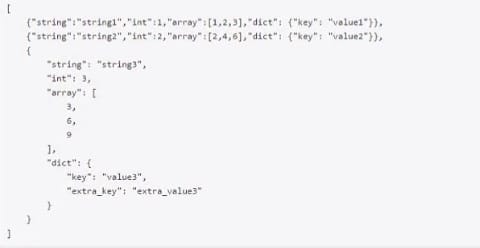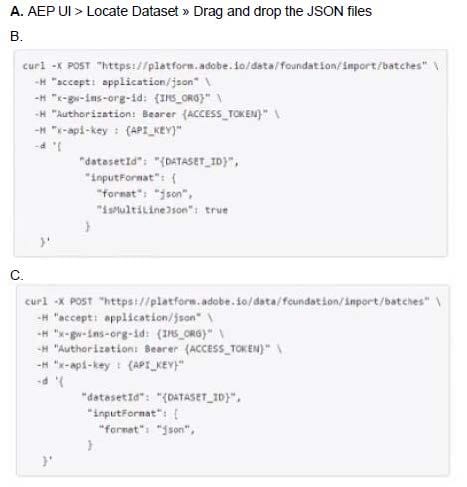Exam Details
Exam Code
:AD0-E600Exam Name
:Adobe Experience Platform Technical FoundationsCertification
:Adobe CertificationsVendor
:AdobeTotal Questions
:50 Q&AsLast Updated
:Aug 23, 2025
Adobe Adobe Certifications AD0-E600 Questions & Answers
-
Question 31:
A data engineer is required to partially ingest data via a Source Connector. Which three source connectors are permitted for this task? (Choose three.)
A. FTP/SFTP
B. HTTP API
C. Adobe Analytics
D. Azure Blob Storage
E. Microsoft Dynamics
F. Web SDK
-
Question 32:
A data engineer is using Data Prep to format data for ingestion. The data engineer needs to load Date/Time as Date values for a field called CustomerCreateDate. The use of this field does not require a time component and as is String
based.
The JSON value in this example is '.platosaprod.customerCreateDateVZOOS-11 -0415:44".
Which Data Prep functions and order should the data engineer use to format the date without the time component?
A. format(p'atosaprod.custometCreateDate.dd-MM-yyyy')
B. format(date(_platosaprod.customerCreateDate),'dd-MM-yyyy')
C. dformaUdateLP'atosaprod.customerCreateDateJ.'dd-MM-yyyy')
D. date(_platosaprod.customerCreateDate.'dd-MM-yyyy')
-
Question 33:
Given thefollowing:

How should a data engineer ingest this data?

A. Option A
B. Option B
C. Option C
-
Question 34:
An AEP expert has been tasked with a last-minute request to send a campaign. The AEP expert needs to upload a CSV file with the customer list that will be affected through the campaign, create the segments based on a briefing, and share
those segments with Adobe Campaign and Facebook Custom Audiences. The brief also includes the segment volumes.
Before sharing the segments, the AEP expert needs to make sure that the segment volumes match the briefing.
What should the AEP do right after creating the segments to get the volumes?
A. Run a Segment Job through the API for the segments created
B. Use the qualified profiles value that appears in the Segment builder
C. Use the Profiles over time graph that appears on the segment details
D. Create an AEP dashboard with an Audience Size widget and select the corresponding segments
-
Question 35:
During discovery, a business user explains that customer data from field-sales reps is stored in a third-party CRM system.
Based on the three methods of ingesting data into Adobe Experience Platform, which method should be used to set up a schedule-based ingestion run?
A. Batch API
B. Streaming API
C. Sources
D. File automation
-
Question 36:
An organization it migrating an m-house built customer database to Adobe Experience Platform. As part of the migration the services that are connected into the customer database must continue to work. One of those services is a Customer Care platform that is pulling the customer and product details using a REST API call. In AEP. the product details will be modeled using a custom XDM Class. The primary identity, product ID. will be linked to a Namespace with the type "Non People Identifier". That field will be used to create a relationship with the main Profile XDM schema.
Which option should be used to allow the Customer Care to retrieve product details through the product ID?
A. Trigger an API event into Journey Optimizer and run a Journey to retrieve the product data
B. Use a SQL client in the Customer Care platform and connected into the AEP Query Service
C. Use a Runtime function in Adobe I/O that retrieves the product data using the Data Access API
D. Enable the products dataset for profile and use the Real-time Profile API
-
Question 37:
What is model scoring in the Data Science Workspace?
A. Building and evaluating a model
B. Engineering features for a model
C. Building a recipe
D. Applying a model to a data set
-
Question 38:
A B2B business (the client) is migrating its data warehouse (DWH) solution to AEP. Currently, they are using what they call Recipient ID as the main identifier to recognize client employees. That Recipient 10 is generated inside the DWH.
That solution will not be available once AEP is live, so the solution architect needs to consider potential alternatives.
After working with the client lead and a data engineer, the solution architect identifies that a combination of Company ID and Hashed Employee Email would be a good replacement for the Recipient ID to make it more unique.
How can the solution architect generate that identity within AEP?
A. The Company ID (non-people identifier) must be set up as a primary ID. The Hashed Employee Email as a secondary ID and AEP will automatically reconcile them.
B. The Company ID and Hashed Employee Email must be combined in AEP data prep and passed as a unique primary identity.
C. The Company ID and Hashed Employee Email must be combined outside of AEP and passed as a unique primary identity.
D. The Hashed Employee Email must be set up as a primary ID. The Company ID (non- people identifier) as a secondary ID and AEP will automatically reconcile them.
-
Question 39:
After creating the Entity Relationship (Diagram (ERD) of the data sources that will be connected into an AEP implementation for a utility company, the service details (including information such as name, cost type, and category) appear multiple times across different entities (for example, in the transactional events and m the customer profile details).
When designing the XDM data model for that ERD, the data architect and the business stakeholders validate that the service details information must be included at both levels, record, and time series. The service details will be used multiple times within the same structure.
How should the service details be defined in the AEP data model to make it consistent and re-usable?
A. Create a XDM Schema
B. Create a Field Group
C. Create a XDM Class
D. Create a Data Type
-
Question 40:
A data architect creates two XDM schemas: Schema A and Schema B.
What are the two requirements for defining a schema relationship so that Schema A references Schema B for use in segmentation? (Choose two.)
A. Schema A and Schema 6 must each be enabled for Real-time Customer Profile.
B. Schema A and Schema B must each have a primary identity.
C. Schema A must belong to the same schema class as Schema B.
D. Schema A and Schema B must each have datasets associated with them.
E. Both schemas should have the same fields marked as identities.
Related Exams:
9A0-019
Adobe Photoshop 6.0 Product Proficiency9A0-042
Acrobat 7.0 Prowith Adobe LiveCycle Designer ACE Exam9A0-043
Adobe Illustrator CS 2 ACE9A0-044
Adobe Photoshop CS 2 ACE Exam9A0-045
Adobe InDesign CS 2 ACE Exam9A0-046
Adobe GoLive CS2 ACE Exam9A0-055
Adobe InDesign CS3 ACE Exam9A0-056
Adobe Dreamweaver CS3 ACE Exam9A0-057
Adobe Illustrator CS3 ACE Exam9A0-058
Adobe Flash CS3 ACE Exam
Tips on How to Prepare for the Exams
Nowadays, the certification exams become more and more important and required by more and more enterprises when applying for a job. But how to prepare for the exam effectively? How to prepare for the exam in a short time with less efforts? How to get a ideal result and how to find the most reliable resources? Here on Vcedump.com, you will find all the answers. Vcedump.com provide not only Adobe exam questions, answers and explanations but also complete assistance on your exam preparation and certification application. If you are confused on your AD0-E600 exam preparations and Adobe certification application, do not hesitate to visit our Vcedump.com to find your solutions here.